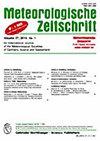2023 年冰岛雷克雅未克 Fagradalsfjall 火山喷发期间火山二氧化硫对太阳紫外线辐照度的影响
IF 1.7
4区 地球科学
Q4 METEOROLOGY & ATMOSPHERIC SCIENCES
引用次数: 0
摘要
二氧化硫是一种重要的大气气体,可以减弱太阳紫外线辐射。在污染严重的地区,特别是在火山羽流中,二氧化硫的含量更高。在 2023 年 7 月 10 日至 8 月 5 日冰岛火山系统 Fagradalsfjall 喷发期间,二氧化硫羽流于 2023 年 7 月 24 日到达首都雷克雅未克,经 B199 MkIII 布鲁尔分光光度计测量,二氧化硫气体柱达到近 50 DU。二氧化硫浓度的增加导致紫外线指数下降了约 25%,而 2023 年 7 月 23 日仅下降了 1%,当时记录到的二氧化硫高达 3.6 DU。在紫外线光谱中,二氧化硫主要影响波长约为 325 纳米以下的短波,超过这一波长的影响可以忽略不计。2023 年 7 月 24 日,50 DU 二氧化硫柱导致 296 纳米波长的紫外线辐照度降低了 79%以上。模型模拟显示,100 DU 二氧化硫柱将使该波长的紫外线辐照度衰减 96%。二氧化硫对维生素 D 加权太阳紫外线辐照度的影响甚至大于对紫外线指数的影响,因为 50 DU 二氧化硫柱会导致维生素 D 加权太阳紫外线辐照度下降 37%,而潜在的 100 DU 二氧化硫柱会导致维生素 D 生成量下降 58%。本文章由计算机程序翻译,如有差异,请以英文原文为准。
Effect of volcanic sulfur dioxide on solar UV irradiance during the 2023 Fagradalsfjall eruption in Reykjavík, Iceland
Sulfur dioxide is an important atmospheric gas that can attenuate solar ultraviolet radiation. It can be found in greater quantities in highly polluted areas and especially in volcanic plumes. During the eruption of the Icelandic volcanic system Fagradalsfjall, which lasted between 10 July and 5 August 2023, the sulfur dioxide plume reached the capital city Reykjavík on 24 July 2023, resulting in almost 50 DU column of this gas, as measured by a B199 MkIII Brewer spectrophotometer. The increased sulfur dioxide concentration resulted in ~25 % reduction in UV Index, compared to only 1 % decrease on 23 July 2023, when up to 3.6 DU sulfur dioxide were recorded. In the UV spectrum, sulfur dioxide affected mostly short wavelengths up to approximately 325 nm, above which the effects were negligible. On 24 July 2023, a 50 DU sulfur dioxide column lead to more than 79 % reduction of UV irradiance at 296 nm. Model simulations showed that a 100 DU column sulfur dioxide would attenuate 96 % of UV irradiance at this wavelength. The effects of sulfur dioxide on vitamin D weighted solar UV irradiance were even greater than on UV Index, as a 50 DU sulfur dioxide column caused a 37 % decline in vitamin D weighted solar UV irradiance, and a potential 100 DU column of this gas would lead to a 58 % reduction of vitamin D production.
求助全文
通过发布文献求助,成功后即可免费获取论文全文。
去求助
来源期刊

Meteorologische Zeitschrift
地学-气象与大气科学
CiteScore
2.80
自引率
8.30%
发文量
19
审稿时长
6-12 weeks
期刊介绍:
Meteorologische Zeitschrift (Contributions to Atmospheric Sciences) accepts high-quality, English language, double peer-reviewed manuscripts on all aspects of observational, theoretical and computational research on the entire field of meteorology and atmospheric physics, including climatology. Manuscripts from applied sectors such as, e.g., Environmental Meteorology or Energy Meteorology are particularly welcome.
Meteorologische Zeitschrift (Contributions to Atmospheric Sciences) represents a natural forum for the meteorological community of Central Europe and worldwide.
 求助内容:
求助内容: 应助结果提醒方式:
应助结果提醒方式:


